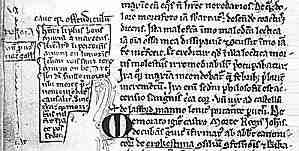






If you are looking at this page without frames, there is more information about medieval writing to be found by going to the home page (framed) or the site map (no frames).
| Scribal Errors and Corrections (2) | ||||
 |
Segment from a 14th century copy of Dante's Divine Comedy (British Library, add. ms. 19587), by permission of the British Library. | |||
| The letters nro for nostro are interpolated in superscript in the second line above. This is in an elegantly written and lavishly illustrated volume of the work. | ||||
| A few words from St Augustine, De Civitate Dei (British Library, add. ms. 15246, f.29). (From The New Palaeographical Society 1911) | ||||
| The above is from an exceptionally lavish Renaissance manuscript, written for a wealthy Italian patron and lavishly embellished. It is purely coincidence that the word written above the line is errore. That is, in fact, the missing word. | ||||
| One might think that legal documents should have no corrections or alterations, and usually that is the case. They were usually produced by scribes writing out standard formulae over and over again. The following example has a whole interpolated sentence inserted between the lines, however. | ||||
 |
||||
| Segment of a writ of Edward III of 1328 (Westminster Abbey, Muniments. Coronation No. II). (From The New Palaeographical Society 1910) | ||||
| This writ orders the abbot and convent of Westminster to hand over to the sheriffs of London the stone on which the Scottish kings were accustomed to sit at their coronation. The interpolated words read Et ce en nulle manere ne lessez (And in no manner fail). They didn't hand over the stone for another 600 years. | ||||
| Manuscript works generally had wide margins on each page, used for all manner of additions, including corrections. | ||||
 |
Grab from a 9th century copy of Rabanus Maurus Commentary on the Epistles of St Paul (Cambridge, Pembroke College, MS 308, f.42). (From The New Palaeographical Society 1912) | |||
| In this example, the last four letters and abbreviation mark of the word dimittentur appear to have been added in a smaller hand, extending into the margin of the page. | ||||
 |
A little segment from a Life of St Gilbert of Sempringham,of 1451 (British Library, add. ms. 36704). (From The New Palaeographical Society 1905) | |||
| In the above example the additional words & his are entered in the margin. One red vertical line indicates where this is to go in the text and another indicates the text to be inserted. | ||||
 |
A few lines from a miniature 13th century Bible, from a private collection. | |||
| The dense packing of both letters and lines in a miniature Bible does not leave much room for corrections. The omitted word testamentum has been squeezed into the margin, and an irregular red box drawn around it to show where it goes. This technique was also used where whole sentences, or even paragraphs, needed to be inserted. | ||||
 |
Segment from the mid 13th century Historia Anglicorum of Matthew Paris (British Library, Royal 14 C VII), by permission of the British Library. | |||
| The above is an autograph copy of the work, and is covered in marginal additions, both in the author's hand and many later notes | ||||
| Sometimes the words got into the wrong order. The oblique double hairlines above the words Uocauitque and firmamentum are supposed to represent marks of transposition. | ||||
 |
||||
| Enlarged sample from a mid 13th century Bible (British Library, Burney MS 3). (From Thompson 1912) | ||||
If you are looking at this page without frames, there is more information about medieval writing to be found by going to the home page (framed) or the site map (no frames). |
||||